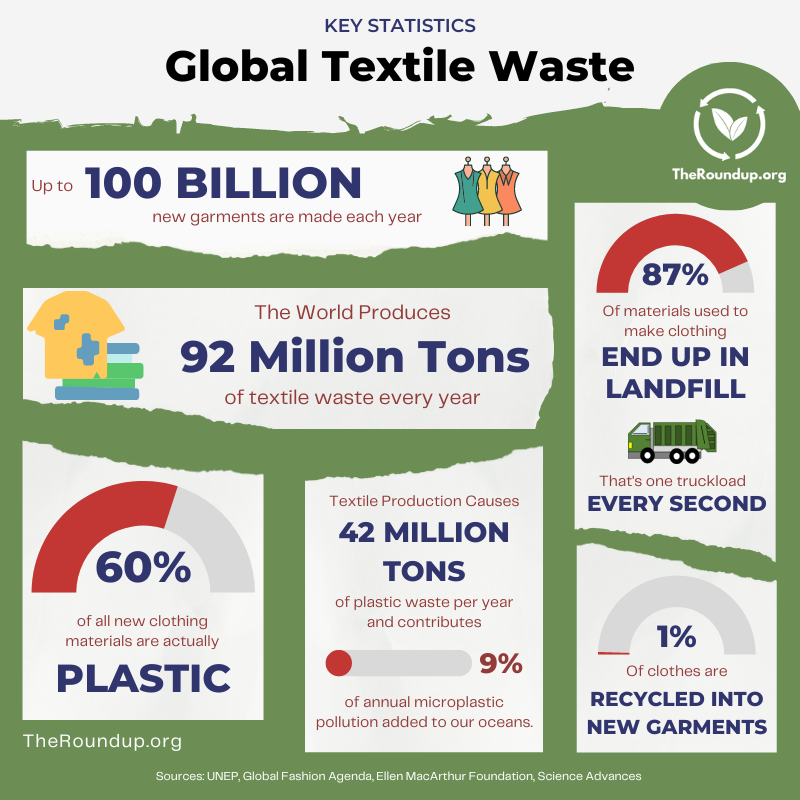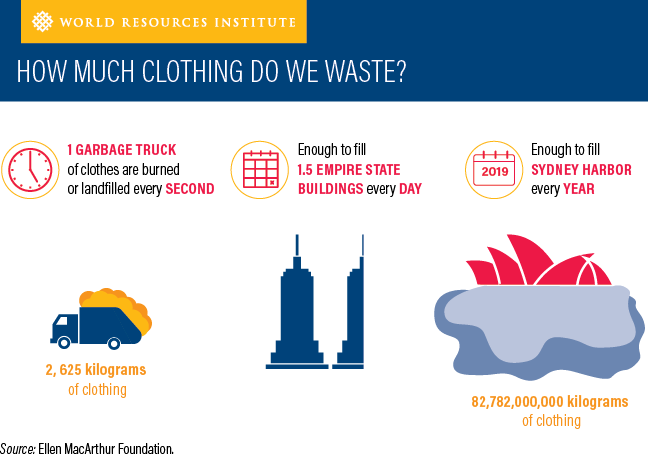The facts.
-
The world produces 92 million tonnes of textile waste every year
-
The world sends the equivalent of 1 truckload of clothing every second to the landfill
-
80% of our apparel is made by young women between the ages of 18-24
The big picture.
It’s often said that the U.S. is a place where the luxuries are cheap and the necessities are expensive. Clothing is small part of Americans’ cost of living, unlike housing, education and health care. This has led to commonplace habits and vernacular such as “retail therapy” or ”impulse buys” with the end result being significant amounts of clothing waste.
An estimated 92 million tons of textile waste is created annually from the fashion industry. Shockingly, every second, the equivalent of one garbage truck of textiles is landfilled or burned globally.
Where does most of this clothing waste come from?
Overproduction is a huge contributor to clothing waste.
It is estimated that globally 80-150 billion pieces of clothing are made annually, while approximately 15-45 billion pieces (20-30%) are never sold. Manufacturers regularly overproduce clothing. There are several reasons for this, some are business decisions while others are strategically made to influence the customer. Let’s look at some of these reasons.
-
Competitive Pricing – Producers get a better price for making more items. This is logical and makes sense to us as consumers when we think about stores like Costco. The economies of scale gained here help to keep the price low for consumers.
-
Managing lead times – Many fabrics have long lead times for ordering so brands will order more to avoid shortfalls. Managing the supply chain to ensure that products end up on hangers at the right time and right quantities is an important part of meeting customer expectations.
-
Ability to meet demand – Brands are unable to accurately predict which trends will be popular. They are often launching several styles at a time and since they cannot tell which ones will be in high demand, they make an abundant supply to ensure that they are prepared for customer responses.
-
Store merchandising – A well stocked store creates an illusion of abundance resulting in consumers buying more. For this reason, manufacturers make extra so that stores can be filled with lots of product
-
Fast production cycles – Fast Fashion is a major contributor to overproduction and clothing waste. These retailers have a short window of a few weeks to get the most number of clothing items sold before the next trend is released. As a result, they manufacture large quantities to ensure that there isn’t a shortfall but then have to quickly get rid of the extras when a the next trend is released.
Clothing returns also impact clothing waste.
In the USA, returning goods from e-commerce is significantly higher (20-30%) than from a traditional store (8-10%). This makes sense, especially when you consider that one has the opportunity to try on the clothing before buying, whereas online, It is not unusual to purchase several sizes of an item of clothing and return the ones that don’t fit. In fact, apparel is the biggest return rate (26%) of all categories. Electronics on the other hand is as low as 7%. Most of the returns are for legitimate reasons such as size or defects but fraudulent returns complicate the problem. These account for approximately 14% of all returns and are on the rise.
Apparel returns are particularly difficult since each item has to be inspected and cleared for resale. 30% Of consumers admit to “wardrobing” (ie) buying an item of clothing, wearing it once and then returning it. 48% Of these folks do this several times a year. If there are stains or damage, the retailer cannot sell this as new and needs to find an alternative means of sale or disposal. This is a time and labor intensive process.
Consumers are typically slow at returning items. 85% Of people admit that it takes longer than they’d like due to the inconvenience. This is especially a problem with fast fashion since each passing day erodes away at the already short trend cycle, making the return ultimately unusable.
Additionally, the multiple channels of returns (eg) return in store, drop off with QR code, add to logistics complexity. A few years ago, a Canadian TV show called “Marketplace” bought several items from Amazon and then returned them with a GPS tracker. They showed that some of these items traveled hundreds of miles with various pit stops before some ended up in a landfill.
So what happens to these returns?
Some sources suggest that only a minimum are actually resold. In 2020, it was estimated that 2.6 million tonnes of returns ended up in landfills. The process of returns has gotten so complicated, time intensive and expensive for retailers that it often makes more financial sense for them to destroy or throw away the items than get them back into circulation.
Some estimates suggest that retailers can lose as much as $33 for every $50 of returned items. Most people assume that these are resold but that is definitely not the case. Returns are in fact, a large source of clothing waste.
The impact of throw away culture.
According to Road Runner Recycling, the average US consumer throws away approximately 81.5 pounds of clothes annually, leading to an estimated 11.3 million tons of clothing waste in America alone. Throwaway culture, rapid fashion cycles and social media are big contributors to clothing waste.
• We are buying 60% more clothing than we did in 2000 while we are wearing it approximately 40% less.
• The average piece of clothing is only worn 7 times, we only wear 10% of the clothes in our closet on a day-to-day basis and wear 60% of our clothes for less than a year.
• Of this waste, 66% end up in landfills while 15% are incinerated.
Manufacturing and production design also impacts fashion waste.
Manufacturing waste is another contributor. Approximately 15% of the fabric used in sewing is discarded due to the number of cutouts which are needed to make clothing. Zero waste design is an up and coming concept aimed at solving this problem.
So what is the impact of clothing waste?
Our waste impacts other people’s lives in many ways.
-
People living near landfills often have health problems such as low birth weights and higher forms of certain types of cancers. These tend to affect people of a lower socioeconomic status disproportionately.
-
Charities such as Goodwill receive so many clothes that they will not be able to sell them all. Many of these are exported to other countries with good intentions, however, almost 40% are unusable and end up as garbage. The OR Foundation estimates 15 million individual pieces of clothing end up in Ghana weekly. Locals also burn large piles of clothing to create space resulting in air pollution and respiratory challenges.
All of this waste has several detrimental impacts on the environment.
One of the biggest, which is hard to truly quantify, is that discarded clothing travels long distances, often globally, before ending up in landfills. The true GHG and carbon impact of this is unknown. Once they end up in landfills, some known impacts are;
-
Clothing slowly degenerates resulting in methane emissions.
-
Since 60% of clothing is actually made of plastic, microplastic leaching is a major problem.
-
There is so much waste clothing that it clogs waterways and gutters, leading to flooding.
The choices
Life-focused
If your focus is on being kind to living things . . .
-
Stop supporting fast fashion brands – they are the biggest contributor to factory worker abuse
-
Try to find a new home for your reusable clothing that you will not wear – small local non-profits are better at putting them to use, neighborhood clothing swaps are highly effective.
-
Unfollow and do not support social media brands and influencers who promote fast replacement cycles, especially if they involve animal byproducts (ie) silk.
Earth-focused
If your focus is on the earth and environment . . .
-
Buy well made clothes with sustainable materials
-
Repair clothing and try to wear them as much
-
Resell clothing which you want to get rid of
-
Consider renting clothes for special occasions
Holistic
If you are considering both a life and environmental focus . . .
-
Reduce consumption. Do not buy an item unless you can picture yourself wearing it years from now.
-
Think about how and where you buy clothing. Research online vs brick and mortar and make decisions about how that applies to your buying situations – this is nuanced and the decision may be different for clothes vs other purchases.
-
Think twice about ordering more items with the plans to return the ones that don’t fit.
-
Educate yourself and support companies working on circularity in fashion.






